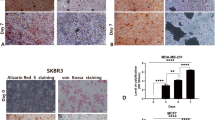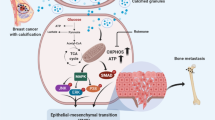Abstract
Microcalcifications containing calcium hydroxyapatite (HA) are often associated with malignant human breast lesions. Frequently, they are the only mammographic features that indicate the presence of a tumoural lesion. We previously reported the induction of both mitogenesis and prostaglandin E2 (PGE2) production and the increased activities of matrix metalloproteinases (MMPs) MMP-2 and MMP-9 in normal human mammary epithelial cells and breast cancer cell lines, treated with HA. In the present study we attempted to elucidate the mechanism of these biological effects. Firstly, we found that direct cell–crystal contact was required for induction of mitogenesis as the effect was not merely a result of isotopic exchange of calcium into the culture medium. Treatment with bafilomycin A1, a proton pump inhibitor, abrogated HA-induced mitogenesis to control cell levels. These results suggest that phagocytosis and intracellular crystal dissolution is required for HA-induced mitogenesis. We also demonstrated that the increase in prostaglandin E2, previously reported, is due, at least in part, to HA-induced upregulation of cyclooxygenase-2 (COX-2) in Hs578T cells. An accumulation of MMP-1 mRNA was also shown in response to HA stimulation in Hs578T cells. Furthermore, a HA-induced increase in interleukin-1β (IL-1β), a potent inducer of MMP-1 gene expression, was demonstrated in Hs578T cells at 2 and 4 h. Treatment with phosphocitrate (PC) (a naturally occurring inhibitor of calcium phosphate crystallisation, which is known to block a number of HA-induced biological effects in other cell types) blocked HA-mediated mitogenesis, as well as, COX-2, MMP-1 and IL-1β induction, at the transcriptional level. These results show that calcium HA crystals are capable of exerting significant biological effects on surrounding cells which can be abrogated by PC and emphasise the role of calcium HA in amplifying the pathological process involved in breast cancer.
Similar content being viewed by others
References
Harris J, Morrow M, Bonnadonna G: Cancer of the Breast. Lippincot, Philadelphia, 1993
Radi M: Calcium oxalate crystals in breast biopsies. An overlooked form of microcalcification associated with benign breast disease. Arch Pathol Lab Med 113: 1367-1369, 1989
Going J, Anderson T, Crocker P, Levison D: Weddellite calcification in the breast: eighteen cases with implications for breast cancer screening. Histopathology 16: 119-124, 1990
Frouge C, Meunier M, Guinebretiere J, Gilles R, Vanel D, Contesso G, Di Paola R, Blery M: Polyhedral microcalcifications at mammography: histological correlation with calcium oxalate. Radiology 186: 681-684, 1993
Holme T, Reis M, Thompson A, Roberton A, Parham D, Hickn P: Is mammographic microcalcification of biological significance. Eur J Surg Oncol 19: 250-253, 1993
Tabar L, Chen H, Duffy S, Yen M, Chiang C, Dean P, Smith R: A novel method for prediction of long-term outcome of women with T1a, T1b, and 10-14 mm invasive breast cancers: a prospective study. The Lancet 355: 429-433, 2000
Morgan M, Cooke M, Christopherson P, Westfall P, McCarthy G: Calcium hydroxyapatite promotes mitogenesis and matrix metalloproteinase expression in human breast cancer cell lines. Mol Carcinogenesis32: 111-117, 2001
Keeling D, Herslof M, Ryberg B, Sjogren S, Solvell L: Vacuolar H(+)-ATPases. Targets for drug discovery? Ann NY Acad Sci 3: 600-608, 1997
Cheung H: Phosphocitrate as a potential therapeutic strategy for crystal deposition disease. Current Rheumatol Rep 3: 24-28, 2001
Honma S, Shimodaira K, Shimizu Y, Tsuchiya N, Saito H, Yanaihara T, Okai T: The influence of inflammatory cytokines on estrogen production and cell proliferation in human breast cancer cell lines. Endocr J 49: 371-377, 2002
Bett J, Christener L, Hall W: J Am Chem Soc 89: 5535-5541, 1967
McCarthy G, Augustine J, Baldwin A, Christopherson P, Cheung H, Westfall P, Scheinman R: Molecular mechanisms of basic calcium phosphate crystal-induced activation of human fibroblasts. J Biol Chem 273: 35161-35169, 1998
McCarthy G, Cheung H, Abel S, Ryan L: Basic calcium phosphate crystal-induced collagenase production: role of intracellular crystal dissolution. Osteoarthritis and Cartilage 6: 205-213, 1998
Nelson A, Fingleton B, Rothenberg M, Matrisian L: Matrix metalloproteinases: biological activity and clinical implications. J Clin Oncol 18: 1135-1149, 2000
Lochter A, Galosy S, Muschler J, Freedman N, Werb Z, Bissell M: Matrix metalloproteinase stromelysin-1 triggers a cascade of molecular alterations that leads to stable epithelialto-mesenchymal conversion and a premalignant phenotype in mammary epithelial cells. J Cell Biol 139: 1861-1872, 1997
McCarthy G, Mitchell P, Cheung H: The mitogenic response to stimulation with basic calcium phosophate crystals is accompanied by induction and secretion of collagenase in human fibroblasts. Arthritis and Rheumatism 34: 1021-1030, 1991
Brogley M, Cruz M, Cheung H: Basic calcium phosphate crystal induction of collagenase 1 and stromelysin expression is dependent on a p42/44 mitogen-activated protein kinase signal transduction pathway. J Cell Physiol 180: 215-224, 1999
Rolland P, Martrin P, Jacquemier J, Rolland A, Toga M: Prostaglandins in human breast cancer: evidence suggesting that an elevated prostaglandin production is a marker of high metastatic potential for neoplastic cells. J Natl Cancer Inst 64: 1061-1070, 1980
Lui X, Rose D: Differential expression and regulation of cyclooxygenase-1 and-2 in two human breast cancer cell lines. Cancer Res. 56: 5125-5127, 1996
Lauri D, Bertomeu M, Orr F, Bastida E, Sauder D, Buchanan M: Interleukin-1 increases tumor cell adhesion to endothelial cells through an RGD dependent mechanism: in vitro and in vivo studies. Clin Exp Metastasis 8: 27-32, 1990
Verhasselt B, Van Damme J, van Larebeke N, Put W, Bracke M, DePotter C, Mareel M: Interleukin-1 is a motility factor for human breast carcinoma cells in vitro: additive effect with interleukin-6. Eur J Cell Biol. 59: 449-457, 1992
Schrey M, Patel K: Prostaglandin E2 production and metabolism in human breast cancer cells and breast fibroblasts. Regulation by inflammatory mediators. Br J Cancer 72: 1412-1419, 1995
Rutter J, Benbow U, Coon C, Brinckerhoff C: Cell-type specific regulation of human interstitial collagenase-1 gene expression by interleukin-1 beta in human fibroblasts and Calcium hydroxyapatite crystals in breast cancer 263 BC-8701 breast cancer cells. J Cell Biochem 66: 322-336, 1997
Tew W, Malis C, Howard J, Lehninger A: Phosphocitrate inhibits mitochondrial and cytosolic accumulation of calcium in kidney cells in vivo. Proc Natl Acad Sci USA 78: 5528-5532, 1981
Shankar R, Crowden S, Sallis J: Phosphocitrate and its analogue N-sulpho-2-amino tricarballylate inhibit aortic calcification. Atherosclerosis 52: 191-198, 1984
Cheung H, Salis J, Struve J: Specific inhibition of basic calcium phosphate and calcium pyrophosphate crystal-induction of metalloproteinase synthesis by phosphocitrate. Biochim Biophys Acta 1315, 1996
Nair D, Misra R, Sallis J, Cheung H: Phosphocritrate inhibits a basic calcium phosphate and calcium pyrophosphate dihydrate crystal-induced mitogen-activated protein kinase cascade signal transduction pathway. J Biol Chem 272:18920-18925, 1997
Bellahcene A, Castronovo V: Expression of bone matrix proteins in human breast cancer: potential roles in microcalcifi-cation formation and in the genesis of bone metastases. Bull Cancer 84: 17-24, 1997
Holme T, Reis M, Thimpson A, Robertson A, Parham D, Hickman P, Preece P: Is mammographic microcalcification of biological significance? Eur J Surg Oncol 19: 250-253, 1993
Author information
Authors and Affiliations
Rights and permissions
About this article
Cite this article
Cooke, M.M., McCarthy, G.M., Sallis, J.D. et al. Phosphocitrate Inhibits Calcium Hydroxyapatite Induced Mitogenesis and Upregulation of Matrix Metalloproteinase-1, Interleukin-1β and Cyclooxygenase-2 mRNA in Human Breast Cancer Cell Lines. Breast Cancer Res Treat 79, 253–263 (2003). https://doi.org/10.1023/A:1023908307108
Issue Date:
DOI: https://doi.org/10.1023/A:1023908307108




